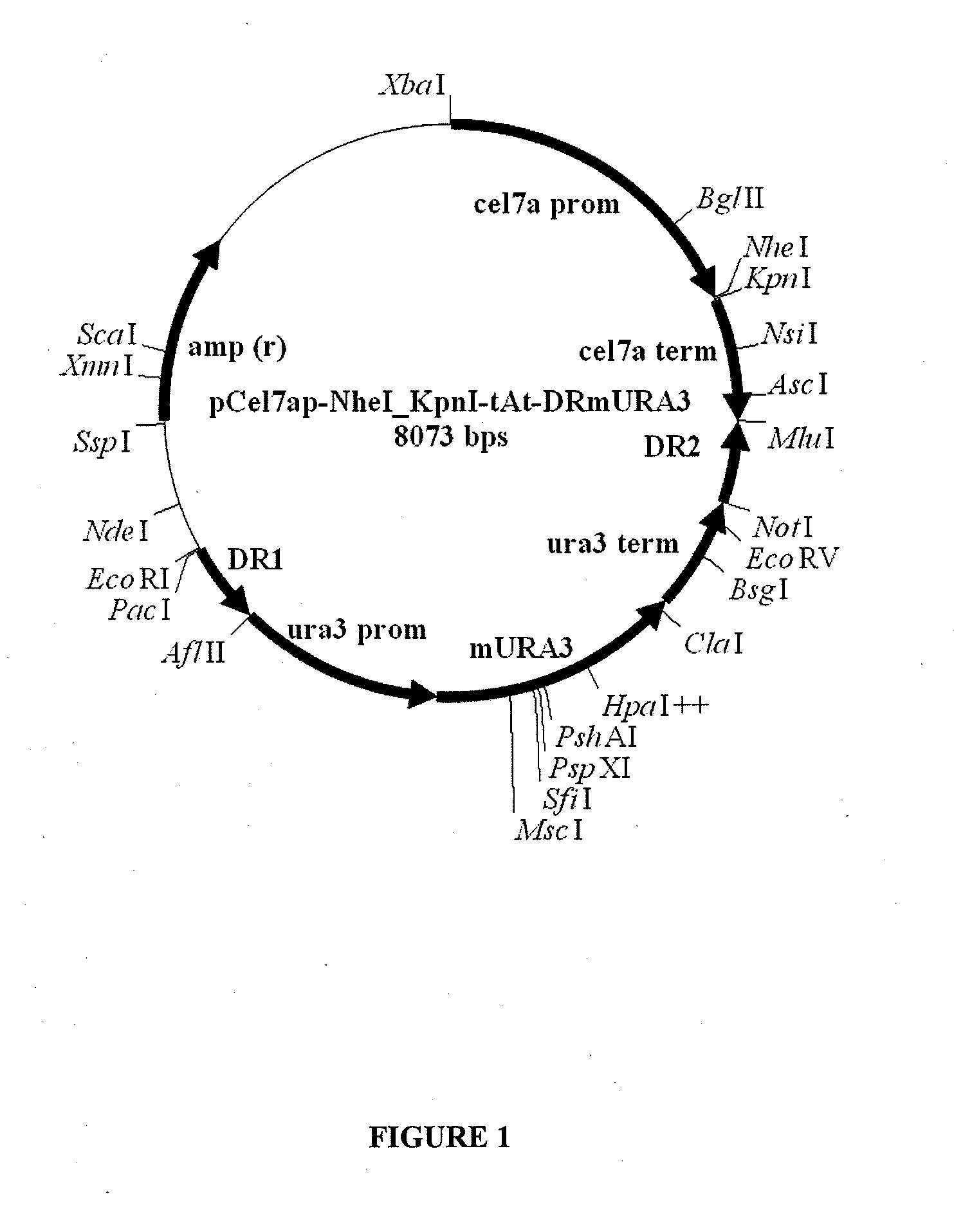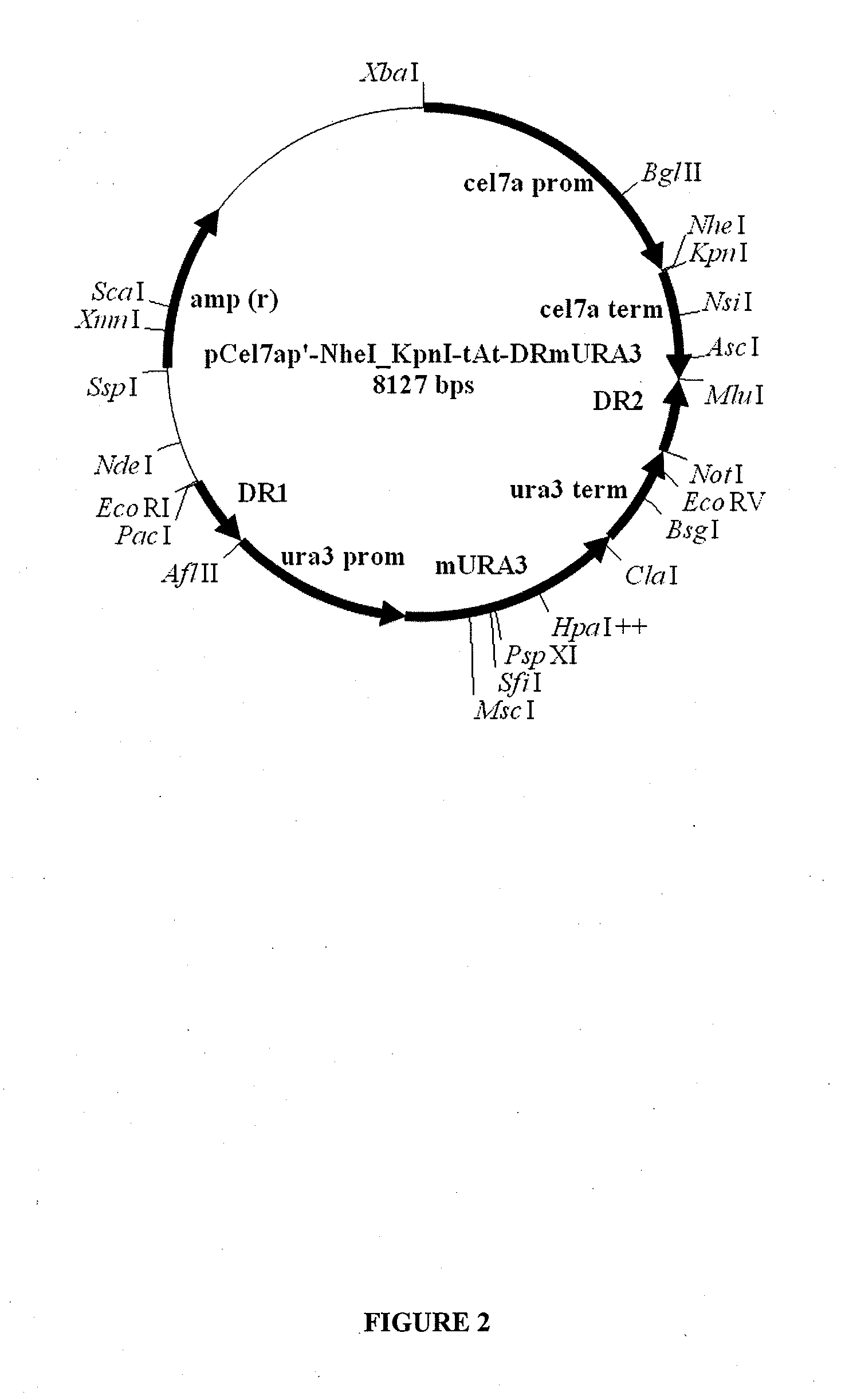Novel cellobiohydrolase enzymes
- Summary
- Abstract
- Description
- Claims
- Application Information
AI Technical Summary
Benefits of technology
Problems solved by technology
Method used
Image
Examples
example 1
Strains and Vectors
[0130]Escherichia coli strain DH5α (F-φ80lacZΔM15 Δ(lacZYA-argF)U169 recA1 endA1 hsdR17(rk−, mk+) phoA supE44 thi-1 gyrA96 relA1 λ−) was obtained from Invitrogen (cat. No. 18265-017 and / or 18258-012). Trichoderma reesei strain P297J, a proprietary strain of Iogen Corporation, is a derivative of T. reesei strain BTR213 from which the genes encoding TrCel7A, TrCel6A and TrCel7B have been deleted (U.S. Publication No. 2010-0221778). Strain BTR213 is a proprietary strain of Iogen Corporation derived from T. reesei strain RutC30 (ATCC® number 56765™). A uridine auxotroph of P297J, P297Jaux4, was obtained through selection of mutants spontaneously resistant to 0.15% w / v 5-fluoroorotic-acid (FOA).
[0131]Plasmid pJET1.2 vector was obtained from Fermentas as a part of the CloneJET™ PCR Cloning Kit (cat. No. K1232). The Trichoderma reesei transformation vectors used to express TrCel7A, TrCel7A-R449E-R450E, and isolated TrCel7A cellobiohydrolases derived therefrom, were eithe...
example 2
Site-Saturation Mutagenesis (SSM) of TrCel7A
[0132]a. SSM PCR
[0133]Site-saturation mutagenesis (SSM) libraries of TrCel7A were generated with primers containing a degenerate codon (NNS) targeting various amino acid positions. SSM was performed using a two-step PCR method involving Megaprimer synthesis followed by PCR-mediated overlap extension. PCR reactions were carried out using iProof™ High-Fidelity DNA Polymerase (Bio-Rad). A vector containing genomic DNA encoding TrCel7A with flanking sequences (SEQ ID NO: 384) was used as the template for the L375X library. A vector containing genomic DNA encoding TrCel7A-R449E-R450Ewith flanking sequences (SEQ ID NO: 385) served as the template for all other SSM libraries.
[0134]For each SSM library, MegaPrimer A was amplified using the external forward primer AC639 with an internal mutagenic reverse primer, while MegaPrimer B was derived by combining the external reverse primer AC640 with an internal mutagenic forward primer. The mutagenic pri...
example 3
Random Mutagenesis of TrCel7A
[0138]a. Error-Prone PCR
[0139]Random mutagenesis libraries were generated by error-prone PCR using Mutazyme® II DNA polymerase (Agilent). Two error-prone PCR were performed. One reaction used 20 fmol of a vector containing a polynucleotide encoding TrCel7A-R449E-R450E and flanking sequences (SEQ ID NO: 442). Another error-prone PCR was performed using 100 fmol of a vector containing a polynucleotide encoding TrCel7A and flanking sequences (SEQ ID NO: 443). Both reactions contained the Mutazyme® II DNA polymerase with primers AC639 and AC640. The annealing temperature was set to 60° C. and the amplification was done for 20 cycles. The error-prone PCR amplicons were subjected to agarose gel electrophoresis and the ˜1.6 kb amplicons were purified from the gel using the Wizard SV® Gel and PCR Clean-Up system (Promega). Primer sequences are shown below:
AC639:(SEQ ID NO: 386)5′ GCGGACTGCGCATCGCTAGCATGTATCGGAAGTTGGCCGTCAC640:(SEQ ID NO: 387)5′ TTCGCCACGGAGCTGGT...
PUM
| Property | Measurement | Unit |
|---|---|---|
| Fraction | aaaaa | aaaaa |
| Fraction | aaaaa | aaaaa |
| Fraction | aaaaa | aaaaa |
Abstract
Description
Claims
Application Information
 Login to View More
Login to View More - R&D
- Intellectual Property
- Life Sciences
- Materials
- Tech Scout
- Unparalleled Data Quality
- Higher Quality Content
- 60% Fewer Hallucinations
Browse by: Latest US Patents, China's latest patents, Technical Efficacy Thesaurus, Application Domain, Technology Topic, Popular Technical Reports.
© 2025 PatSnap. All rights reserved.Legal|Privacy policy|Modern Slavery Act Transparency Statement|Sitemap|About US| Contact US: help@patsnap.com



